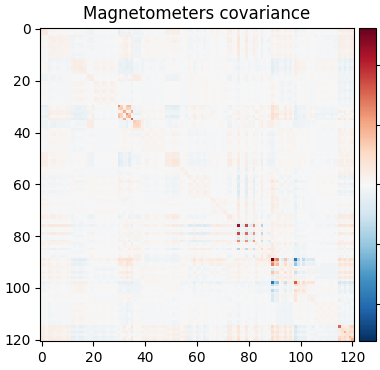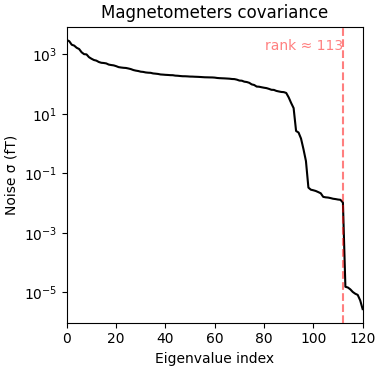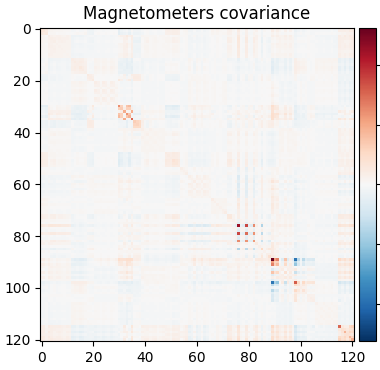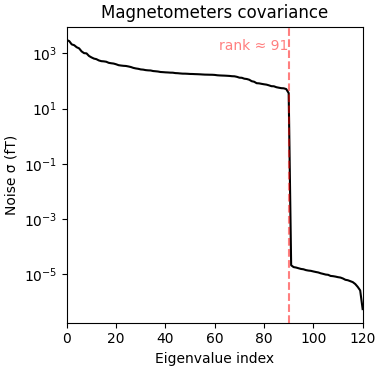Note
Go to the end to download the full example code
Kernel OPM phantom data#
In this dataset, a Neuromag phantom was placed inside the Kernel OPM helmet and stimulated with 7 modules active (121 channels). Here we show some example traces.
# License: BSD-3-Clause
# Copyright the MNE-Python contributors.
import numpy as np
import mne
data_path = mne.datasets.phantom_kernel.data_path()
fname = data_path / "phantom_32_100nam_raw.fif"
raw = mne.io.read_raw_fif(fname).load_data()
events = mne.find_events(raw, stim_channel="STI101")
# Bads identified by inspecting averages
raw.info["bads"] = [
"RC2.bx.ave",
"LC3.bx.ave",
"RC2.by.7",
"RC2.bz.7",
"RC2.bx.4",
"RC2.by.4",
"LC3.bx.5",
]
# Drop the module-average channels
raw.drop_channels([ch_name for ch_name in raw.ch_names if ".ave" in ch_name])
# Add field correction projectors
raw.add_proj(mne.preprocessing.compute_proj_hfc(raw.info, order=2))
raw.pick("meg", exclude="bads")
raw.filter(0.5, 40)
epochs = mne.Epochs(
raw,
events,
tmin=-0.1,
tmax=0.25,
decim=5,
preload=True,
baseline=(None, 0),
)
evoked = epochs["17"].average() # a high-SNR dipole for these data
fig = evoked.plot()
t_peak = 0.016 # based on visual inspection of evoked
fig.axes[0].axvline(t_peak, color="k", ls=":", lw=3, zorder=2)

Opening raw data file /home/circleci/mne_data/MNE-phantom-kernel-data/phantom_32_100nam_raw.fif...
Range : 0 ... 526631 = 0.000 ... 526.631 secs
Ready.
Reading 0 ... 526631 = 0.000 ... 526.631 secs...
1903 events found on stim channel STI101
Event IDs: [ 1 2 3 4 5 6 7 8 9 10 11 12 13 14 15 16 17 18 19 20 21 22 23 24
25 26 27 28 29 30 31 32]
8 projection items deactivated
Filtering raw data in 1 contiguous segment
Setting up band-pass filter from 0.5 - 40 Hz
FIR filter parameters
---------------------
Designing a one-pass, zero-phase, non-causal bandpass filter:
- Windowed time-domain design (firwin) method
- Hamming window with 0.0194 passband ripple and 53 dB stopband attenuation
- Lower passband edge: 0.50
- Lower transition bandwidth: 0.50 Hz (-6 dB cutoff frequency: 0.25 Hz)
- Upper passband edge: 40.00 Hz
- Upper transition bandwidth: 10.00 Hz (-6 dB cutoff frequency: 45.00 Hz)
- Filter length: 6601 samples (6.601 s)
[Parallel(n_jobs=1)]: Done 17 tasks | elapsed: 0.3s
[Parallel(n_jobs=1)]: Done 71 tasks | elapsed: 1.4s
Not setting metadata
1903 matching events found
Setting baseline interval to [-0.1, 0.0] s
Applying baseline correction (mode: mean)
Created an SSP operator (subspace dimension = 8)
8 projection items activated
Using data from preloaded Raw for 1903 events and 351 original time points (prior to decimation) ...
0 bad epochs dropped
The data covariance has an interesting structure because of densely packed sensors:
cov = mne.compute_covariance(epochs, tmax=-0.01)
mne.viz.plot_cov(cov, raw.info)
Computing rank from data with rank=None
Using tolerance 1.5e-08 (2.2e-16 eps * 121 dim * 5.8e+05 max singular value)
Estimated rank (mag): 113
MAG: rank 113 computed from 121 data channels with 8 projectors
Created an SSP operator (subspace dimension = 8)
Setting small MAG eigenvalues to zero (without PCA)
Reducing data rank from 121 -> 113
Estimating covariance using EMPIRICAL
Done.
Number of samples used : 36157
[done]
Computing rank from covariance with rank=None
Using tolerance 2.5e-13 (2.2e-16 eps * 121 dim * 9.2 max singular value)
Estimated rank (mag): 113
MAG: rank 113 computed from 121 data channels with 0 projectors
So let’s be careful and compute rank ahead of time and regularize:
rank = mne.compute_rank(epochs, tol=1e-3, tol_kind="relative")
cov = mne.compute_covariance(epochs, tmax=-0.01, rank=rank, method="shrunk")
mne.viz.plot_cov(cov, raw.info)
Computing rank from data with rank=None
Estimated rank (mag): 91
MAG: rank 91 computed from 121 data channels with 8 projectors
Computing rank from data with rank={'mag': 91}
Created an SSP operator (subspace dimension = 8)
Setting small MAG eigenvalues to zero (without PCA)
Reducing data rank from 121 -> 91
Estimating covariance using SHRUNK
Done.
Number of samples used : 36157
[done]
Computing rank from covariance with rank=None
Using tolerance 2.5e-13 (2.2e-16 eps * 121 dim * 9.2 max singular value)
Estimated rank (mag): 91
MAG: rank 91 computed from 121 data channels with 0 projectors
Look at our alignment:
sphere = mne.make_sphere_model(r0=(0.0, 0.0, 0.0), head_radius=0.08)
trans = mne.transforms.Transform("head", "mri", np.eye(4))
align_kwargs = dict(
trans=trans,
bem=sphere,
surfaces={"outer_skin": 0.2},
show_axes=True,
)
mne.viz.plot_alignment(
raw.info,
coord_frame="meg",
meg=dict(sensors=1.0, helmet=0.05),
**align_kwargs,
)
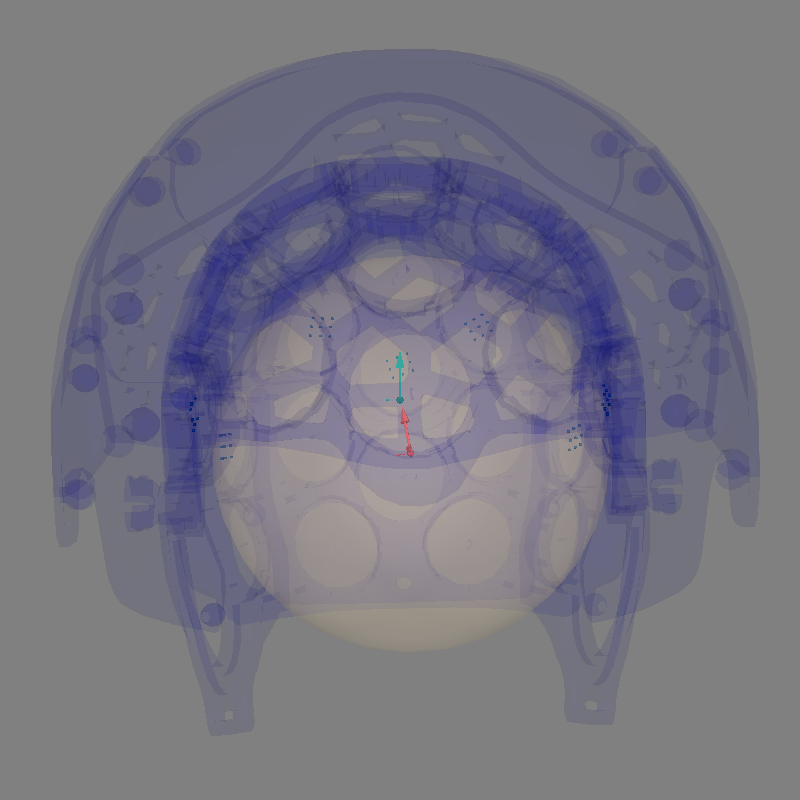
Equiv. model fitting -> RV = 0.00364477 %
mu1 = 0.944121 lambda1 = 0.138646
mu2 = 0.665982 lambda2 = 0.684475
mu3 = -0.140083 lambda3 = -0.0127517
Set up EEG sphere model with scalp radius 80.0 mm
Getting helmet for system Kernel_Flux
Deforming CAD helmet to match 7 acquisition sensor positions:
1. Affine: 4.8°, 4.6 mm, 1.00× scale
2. Nonlinear displacement: mean=1.9, max=6.9 mm
Channel types:: mag: 121
Let’s do dipole fits, which are not great because the dev_head_t is approximate and the sensor coverage is sparse:
data = list()
for ii in range(1, 33):
evoked = epochs[str(ii)][1:-1].average().crop(t_peak, t_peak)
data.append(evoked.data[:, 0])
evoked = mne.EvokedArray(np.array(data).T, evoked.info, tmin=0.0)
del epochs
dip, residual = mne.fit_dipole(evoked, cov, sphere, n_jobs=None)
actual_pos, actual_ori = mne.dipole.get_phantom_dipoles()
actual_amp = np.ones(len(dip)) # fake amp, needed to create Dipole instance
actual_gof = np.ones(len(dip)) # fake GOF, needed to create Dipole instance
dip_true = mne.Dipole(dip.times, actual_pos, actual_amp, actual_ori, actual_gof)
fig = mne.viz.plot_alignment(
evoked.info, coord_frame="head", meg="sensors", **align_kwargs
)
mne.viz.plot_dipole_locations(
dipoles=dip_true, mode="arrow", color=(0.0, 0.0, 0.0), fig=fig
)
mne.viz.plot_dipole_locations(dipoles=dip, mode="arrow", color=(0.2, 1.0, 0.5), fig=fig)
mne.viz.set_3d_view(figure=fig, azimuth=30, elevation=70, distance=0.4)
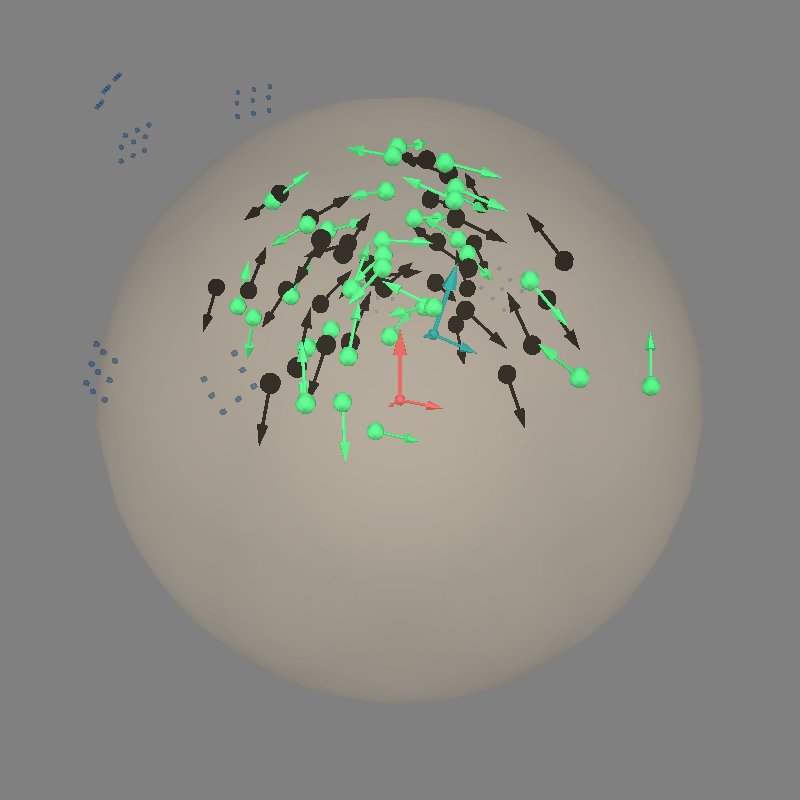
BEM : <ConductorModel | Sphere (3 layers): r0=[0.0, 0.0, 0.0] R=80 mm>
MRI transform : identity
Sphere model : origin at ( 0.00 0.00 0.00) mm, rad = 0.1 mm
Guess grid : 20.0 mm
Guess mindist : 5.0 mm
Guess exclude : 20.0 mm
Using normal MEG coil definitions.
Noise covariance : <Covariance | kind : full, shape : (121, 121), range : [-1.9e-24, +2.6e-24], n_samples : 36156>
Coordinate transformation: MRI (surface RAS) -> head
1.000000 0.000000 0.000000 0.00 mm
0.000000 1.000000 0.000000 0.00 mm
0.000000 0.000000 1.000000 0.00 mm
0.000000 0.000000 0.000000 1.00
Coordinate transformation: MEG device -> head
0.981060 -0.039414 -0.189651 0.00 mm
0.085832 0.966167 0.243215 10.00 mm
0.173648 -0.254887 0.951251 20.00 mm
0.000000 0.000000 0.000000 1.00
0 bad channels total
Read 121 MEG channels from info
105 coil definitions read
Coordinate transformation: MEG device -> head
0.981060 -0.039414 -0.189651 0.00 mm
0.085832 0.966167 0.243215 10.00 mm
0.173648 -0.254887 0.951251 20.00 mm
0.000000 0.000000 0.000000 1.00
MEG coil definitions created in head coordinates.
Decomposing the sensor noise covariance matrix...
Created an SSP operator (subspace dimension = 8)
Computing rank from covariance with rank=None
Using tolerance 2.5e-13 (2.2e-16 eps * 121 dim * 9.2 max singular value)
Estimated rank (mag): 91
MAG: rank 91 computed from 121 data channels with 8 projectors
Setting small MAG eigenvalues to zero (without PCA)
Created the whitener using a noise covariance matrix with rank 91 (30 small eigenvalues omitted)
---- Computing the forward solution for the guesses...
Making a spherical guess space with radius 72.0 mm...
Filtering (grid = 20 mm)...
Surface CM = ( 0.0 0.0 0.0) mm
Surface fits inside a sphere with radius 72.0 mm
Surface extent:
x = -72.0 ... 72.0 mm
y = -72.0 ... 72.0 mm
z = -72.0 ... 72.0 mm
Grid extent:
x = -80.0 ... 80.0 mm
y = -80.0 ... 80.0 mm
z = -80.0 ... 80.0 mm
729 sources before omitting any.
178 sources after omitting infeasible sources not within 20.0 - 72.0 mm.
170 sources remaining after excluding the sources outside the surface and less than 5.0 mm inside.
Go through all guess source locations...
[done 170 sources]
---- Fitted : 0.0 ms
---- Fitted : 5.0 ms
---- Fitted : 10.0 ms
---- Fitted : 15.0 ms
---- Fitted : 20.0 ms
---- Fitted : 25.0 ms
---- Fitted : 30.0 ms
---- Fitted : 35.0 ms
---- Fitted : 40.0 ms
---- Fitted : 45.0 ms
---- Fitted : 50.0 ms
---- Fitted : 55.0 ms
---- Fitted : 60.0 ms
---- Fitted : 65.0 ms
---- Fitted : 70.0 ms
---- Fitted : 75.0 ms
---- Fitted : 80.0 ms
[Parallel(n_jobs=1)]: Done 17 tasks | elapsed: 0.9s
---- Fitted : 85.0 ms
---- Fitted : 90.0 ms
---- Fitted : 95.0 ms
---- Fitted : 100.0 ms
---- Fitted : 105.0 ms
---- Fitted : 110.0 ms
---- Fitted : 115.0 ms
---- Fitted : 120.0 ms
---- Fitted : 125.0 ms
---- Fitted : 130.0 ms
---- Fitted : 135.0 ms
---- Fitted : 140.0 ms
---- Fitted : 145.0 ms
---- Fitted : 150.0 ms
---- Fitted : 155.0 ms
Projections have already been applied. Setting proj attribute to True.
32 time points fitted
Channel types:: mag: 121
Total running time of the script: (0 minutes 42.223 seconds)
Estimated memory usage: 1345 MB
